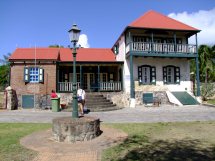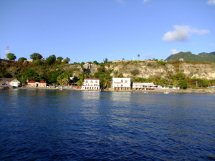(Blog No.67) Nevis - St. Eustatius (Statia)

Catou
Paul and Sylvie Tucker
Mon 18 Apr 2011 10:00
17:28.90N 62:59.34W
Nevis - this island of peace and tranquility. At
2345 hrs it was shattered by some gigantic mega powerful speakers that
started up on the beach about 200 yards away. I think they must have been
aimed at 'Catou'. They were deafening - and they didn't stop until either
3am or 4 am - I was too tired to notice the time. I seriously considered
putting to sea immediately, but in the end we stuck it out.
So, Sunday morning we were up at 0645 and decided to
slip the mooring and set sail, having breakfast on the hoof (fresh mangos
obtained from Thomas the Montserrat taxi driver's Jehovah's witness preacher
man! How's that for a mouthful?). We had a lovely sail (again) up the west
coast of St Kitts. It is a stunningly beautiful island from the sea,
rising to over 3700 ft. It was in fact the very first British Caribbean colony,
settled by Sir Thomas Warner with a few settlers in 1623. Today there are some
beautiful old plantation houses which have been turned into gracious hotels and
inns. If any of you know of National Trust-owned Snowshill Manor in the
Cotswolds, there is a famous and unique collection of artifacts considered
to be of great artistic quality. It was all collected by a man called
Charles Wade, and his family had made their fortune with a sugar
plantation in St. Kitts. Wade sold up and moved to England - probably a wise
decision in hindsight.
St. Kitts has been, until recently one of only
three remaining sugar producing territories in the English speaking
Caribbean (the others being Barbados and Guyana), but St. Kitts closed down
their Sugar factory about 4 years ago (we used to supply them with goods).
As a result, unemployment has soared, drug-related crime
has increased, corruption is rife ... the place is
in a real mess now. Best to look at it from the sea! St Kitts
was one of the islands that the British and French fought over on a regular
basis, taking it from each other several times. The British
build an amazing railway system around the island for collecting the cane.
It was a terrific feat of railway engineering since many bridges had to be
constructed in order to follow the contours of the coastal plains with their
hundreds of years old lava flows. The railway was of narrow gauge
construction. Somehow the gauge used was a very unusual size, and I recall
the English manager of the sugar factory walking me across to a railway siding,
overgrown with cane, just close by the factory, to shown me a
rusting old steam locomotive that was parked there. It didn't look to
me particularly strange, until it was pointed out that it had armor plating
down each side of the old boiler. A little curious in St. Kitts one might
think. It turned out, according to the manager, that the St Kitts sugar
rail gauge was the same as that used in the WWI trenches of northern France.
After the war this loco which had survived, had been shipped out to the
colonies! Well that's what he told me!
2/3rds of the way up the west coast is a huge plug of
lava that sticks out of the gently sloping coastal plains a bit like a
very large mole hill (but it's hundreds of feet high) and is called
Brimstone Hill. The British decided to build a fortress there. When
I was first taken to see it in the early 1980's I thought, 'Oh no, not
another fortress - seen loads before - not another one'. But this
place is truly amazing - the size is quite staggering. It took the British
just over 100 years to build the complete fortress, and the French captured it
almost immediatly, but then the British re-captured it ..... and so on.
Amongst other things, there are the most enormous cannons up there. Heavens
knows how they were dragged up.
Enough of St. Kitts - we didn't even stop there.
We sailed on past to St. Eustatius, an old Dutch colony island that is
known locally as Statia. This tiny island has an amazing history. It
was a huge trading island and in the late 16th century was the largest trading
centre in the Caribbean. According to the pilot book there were up to 300 ships
anchored off the busy harbour in it's heyday. The British were, by
this time fighting the rebel American colonies, and were trying to enforce
embargos - but Statia sold arms and ammunition to the American colonies in their
fight against the British. The island eventually became known as the
Golden Rock because of it's immense wealth. In the late 1770's British
Admiral Rodney captured the island and was billeted here for some
years. He made the rich merchants of the island very
worried. Soon, Rodney noticed that an excessive number of funerals in
ration to the islands population, seemed to be taking place. It was soon
discovered that the merchants were burying all their wealth in the local
graveyard!
Nowadays, Statia has a huge oil refinery as it's
principle industry. As we approached the island we could see about a dozen
tankers, some of them huge and anchored several miles offshore. It seems
amazing for a small island of only a few square miles that such a large-scale
industry can exist. The oil terminal is only about 2 miles to the north of
where we are anchored and at night it looks like a city. The
islands population is a tiny 3400 people.
We had a very hot, but pleasant walk around the upper
town of Oranjestad. Nothing was open (it was Sunday) except a Chinese
bar where we bought a cool drink. Three dogs latched on to us and we
couldn't shake them off. They came into the bar with us, and after we got
rid of two, the original one stuck with us until the very hot and sticky walk
back to the port where our dinghy was. He stood on the concrete quayside,
in two minds about jumping in and swimming after us in the dinghy!!
Supper on board since everywhere was closed.
Sylvie found a lovely Spag Bol in the fridge!
|


